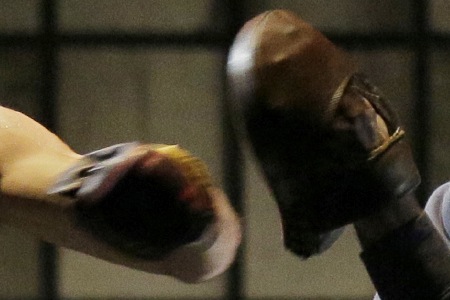Revival of 1930s "Golden Boy" Is an Historical Knockout

Golden Boy
Belasco Theatre
111 W. 44th Street
New York, N.Y.
Boxing truly serves as a window on American history, and indeed, many boxers became legends of twentieth-century America: Jack Johnson, Jack Dempsey, Joe Louis, and, of course, Muhammad Ali. The 1930s, especially, saw the debut of boxing superstars such as Louis and James Braddock. The sweet science is relatively easy to recreate onscreen (countless boxing films, from Rocky and Raging Bull to the more recent The Fighter have proven that) but, given that one typically doesn't expect an actual boxing match during an evening at the theater, it's harder to recreate onstage.
No more. Clifford Odets's Golden Boy, which debuted in 1937 and was revived last week at New York’s Belasco Theatre, is an historical knockout, a tough and powerful drama that captures the sleazy spirit of boxing just before World War II.
Golden Boy is the story of Joe Bonaparte, a muscular, skilled violinist who realizes he can make a lot more money in the ring than he can with his Stradivarius. He fears the ring, though, because he knows that if he mangles his hands he will never play the violin again. But the allure of the arena wins out and Joe steamrolls his way past one opponent after another in dingy fight clubs and tiny arenas until he's a top contender poised for a championship fight. Along the way, he falls in love with Lorna Moon, his manager’s girlfriend, who has a hard time deciding between the two men (the manager has an even more difficult time deciding between Lorna and his wife).
Bonaparte struggles with the members of his middle-class family, who all want him to pursue a career in music. His father, especially, pushes hard for the violin, explaining to Joe that music is a quiet, beautiful life, compared to the bloody sport of boxing.
The show is larger than Joe, who fights in small arenas and for chump change on his way to the top against an array of merciless boxers. It's the story of glitz, glamour, and easy money winning out against the staidness of middle-class existence. And, too, it is a story of the Depression, a time when out of work men climbed into any ring they could find to make a few extra dollars.
The superb play was written seventy-five years ago, but feels like it was finished last week. The first act drags a bit but the second soars when the boxing rings and gloves come out of the set designer’s closet. The sets of Michael Yeargan depict a grimy Depression-era America. Yeargan uses city walls and lighting to create a combination of offices, street corners and city scenes. The boxing arena, with its floor to ceiling windows covered in grime, is wonderful.
Seth Numrich is a tenacious Joe Bonaparte. He twitches and stretches throughout the play, moving his hands and his arms like pieces of an intricate and well-timed machine. He is a volcano of emotions, all of which explode at different points in the play. He is joined by a collection of gifted actors, led by Danny Mastrogiorgio as Tom Moody, Yvonne Strahovski as Lorna, Danny Burstein as trainer Tukio,Tony Shalhoub (of Monk fame) as Joe’s dad, Lucas Caleb Rooney as his brother, Ned Eisenberg as Roxy Gottlieb, and Anthony Crivello as gangster Joe Fuseli.
Boxing in the 1930s was glamorous for champions and contenders, like Bonaparte in the play, but no one else. The average fighter in the ‘30s went into the ring twenty or twenty-five times each year, usually at smaller arenas, and sometimes in clubs that held just a few hundred people. They only earned a few hundred dollars per fight (the equivalent of a couple thousand today), but persisted because they all dreamed of a path to the championship. Those fighters, like Bonaparte, risked serious injury, especially to their hands, every night in careers. It was a tough life of broken noses and cauliflower ears. Today, top boxers fight only two to four times a year for huge paydays, including the arena gate, cable TV, and pay-per-view that account for millions of dollars and worldwide fame.
Boxers in the 1930s also had to deal with organized crime, as Bonaparte does in the play. The mob muscled (no pun intended) into the boxing world because there was so much money to be made off bookmaking. The boxing world continued to be influenced by organized crime through the 1980s. It was a dirty business.
As a window to a bygone era, boxing fans will love Golden Boy, but with its rich cultural subtext, they won't be the only ones.
PRODUCTION: Produced by Lincoln Center Theater. Sets: Michael Yeargan; Costumes: Catherine Zuber; Lighting: Donald Holder; Sound: Peter John Still and Marc Salzberg' Fight Director: B. H. Barry. Golden Boy is directed by Bartlett Sher. The play runs through January 20.
